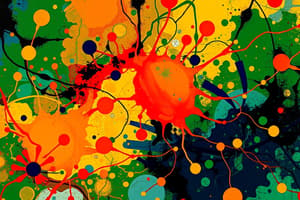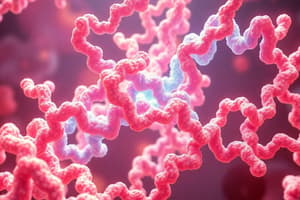Podcast
Questions and Answers
What is the purpose of the peptide bond in the structure of proteins?
What is the purpose of the peptide bond in the structure of proteins?
- To enable the formation of branched polypeptide chains
- To facilitate the cis-configuration of amino acid side-chains
- To allow rotation between amino acid residues
- To provide rigidity and stability to the protein structure (correct)
What is the main difference between a peptide and a polypeptide?
What is the main difference between a peptide and a polypeptide?
- Peptides are shorter than 50 amino acid residues, while polypeptides are longer (correct)
- Peptides are composed of amino acids joined by hydrogen bonds, while polypeptides are joined by peptide bonds
- Peptides can form branched structures, while polypeptides cannot
- Peptides have a N-terminus and C-terminus, while polypeptides do not
What is the role of proline in protein structure?
What is the role of proline in protein structure?
- It provides flexibility and mobility to the protein structure
- It facilitates the cis-configuration of amino acid side-chains
- It causes rigid 'turns' in polypeptides due to its rigid structure (correct)
- It allows for the formation of branched polypeptide chains
What is the relationship between proline and hydroxyproline mentioned in the text?
What is the relationship between proline and hydroxyproline mentioned in the text?
What is the significance of the trans-configuration of amino acid side-chains in proteins?
What is the significance of the trans-configuration of amino acid side-chains in proteins?
What is the relationship between serine, threonine, and enzymatic catalysis mentioned in the text?
What is the relationship between serine, threonine, and enzymatic catalysis mentioned in the text?
What is the significance of the N-terminus and C-terminus mentioned in the text?
What is the significance of the N-terminus and C-terminus mentioned in the text?
Flashcards are hidden until you start studying
Study Notes
Glutathione and Its Forms
- Glutathione is a tripeptide that protects cells from damaging free radicals and reactive oxygen species (ROS).
- It is formed from the side-chain carboxyl group of glutamate, the alpha-amino group of cysteine, and glycine.
- Glutathione has a reduced form (gamma-glutamylcysteinylglycine) and an oxidized form (glutathione disulphide, GSSG), which is formed by two glutathione tripeptides joined by a disulfide bond between the cysteine residues.
Neuropeptides
- Substance P is a neuropeptide containing 11 amino acids, involved in pain perception and vasodilation.
- Vasoactive intestinal peptide (VIP) is a 28-amino acid peptide produced by the intestines, hypothalamus, and other tissues, involved in gut motility and secretion, and circadian rhythms.
Human Peptides
- Enkephalins are pentapeptides (Tyr-Gly-Gly-Phe-Met) with natural opiate (painkilling) activity.
- Enterostatin is a pentapeptide (Ala-Pro-Gly-Pro-Arg) derived from pancreatic procolipase, involved in appetite suppression and increasing satiety.
- Bradykinin is a nonapeptide (nine amino acid residues) that is a powerful vasodilator and anti-inflammatory.
- Angiotensin II is an octapeptide found in lungs and other cells, a powerful vasoconstrictor that raises blood pressure.
- Oxytocin is a nonapeptide that stimulates uterus contraction and milk ejection.
Cyclic Peptides
- Cyclic peptides occur when an amino terminus forms a peptide bond with its carboxy terminus, or an amino terminus covalently bonds with an amino acid side-chain, or a carboxyl terminus covalently bonds with an amino acid side-chain, or two side chains of a peptide covalently bond with each other.
- Examples of natural cyclic peptides include Daptomycin (antibiotic) and Cyclosporine A (immunosuppressant).
Amino Acids and Peptides
- Peptides are short chains of amino acids joined by peptide bonds, with a N-terminus and a C-terminus (except for cyclic peptides).
- A dipeptide contains 2 amino acids linked via a peptide bond, a tripeptide has 3 amino acids, and so on.
- Polypeptides have less than 50 amino acid residues, while proteins have more than 50 amino acid residues.
- The peptide bond is planar and quite rigid, with little rotation allowed, and amino acid residue side-chains (R groups) can be arranged in a cis- or a trans-configuration, with trans-configuration being more common.
Studying That Suits You
Use AI to generate personalized quizzes and flashcards to suit your learning preferences.



